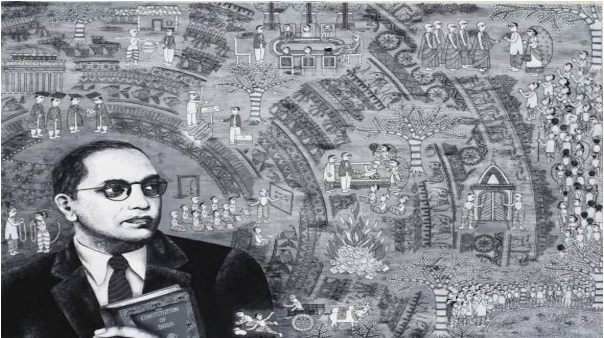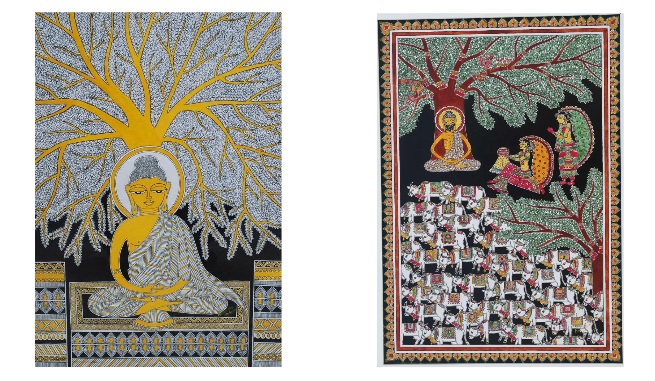Religious histories are often synonymous with legends and myths that root for a king or a demigod who possessed magical powers and eventually uplifted the society from evil towards ‘Dharma’. Fortunately, these legends and folklore have been documented as various visual and performative art forms of the subcontinent. Dalit visual and performative histories have always had less to borrow from the Hindu scriptures and folklore. Their identity often got registered through separate religious and spiritual icons, gods and heroes.
The globally acclaimed style of Madhubani painting, which originates from the upper caste women of the Maithili region who painted their Hindu spirituality on the walls and floors of their houses, reaches the brushes of lower caste women in the 20th century. Their paints and brushes then paint a unique Dalit spirituality with different features, icons and folklore.
Madhubani: From Raja Janak to Raja Sahlesh
Around the 7th century BCE, Raja Janak decided to document the wedding of his daughter Sita to Raja Ram using wall art unique to his kingdom of Mithila (spanning from Bihar to Nepal). Women of the kingdom painted the walls of their huts with natural colours extracted from the Aparajita flower (blue), flat bean leaves (green), Bougainvillea (pink), turmeric (yellow), rice powder (white), charcoal (black). British colonial officer William G. Archer popularised this style as Mithila or Madhubani art.
Maithili art is women’s art. It was traditionally drawn by women using fingers or bamboo brushes and bright-natural colours on huts (Khobar) walls or the floor (Aripana) on social or religious festivals. The origins of Madhubani are contested. While one theory links it with the Ramayana, another idea links the art with the Vamachara school of tantra that was popular in the Mithila region in the 12th century AD, according to Suhrid Sankar Chattopadhyay, who writes about the origins of Madhubani for The Hindu’s Frontline magazine. The tantra subjet of Madhubani was restricted to Brahmin women initially.
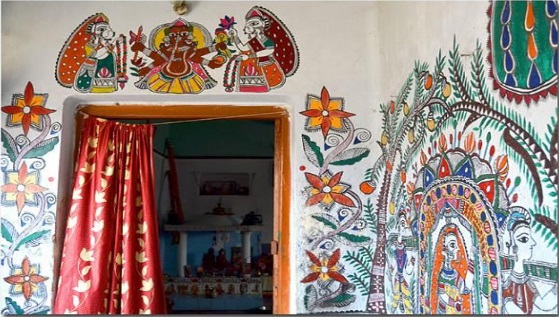
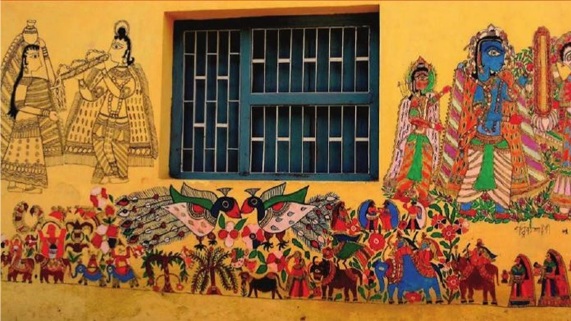
(Courtesy: The Statesman)
The central theme of Madhubani paintings has always been fertility and love. Dikhsha Ahire, in her essay ‘Ulterior motifs – icons & symbols that define Madhubani art’, discusses that Madhubani art was initially practised by Brahmin and Kayastha castes of the Mithila region, who drew flowy and bright religious elements on the floor or the walls. Brahmins preferred the Bharni style, which requires filling the paper with vibrant colours. In contrast, the Kayastha liked the Kachni style, in which repetitive, even lines were used for visual narration.
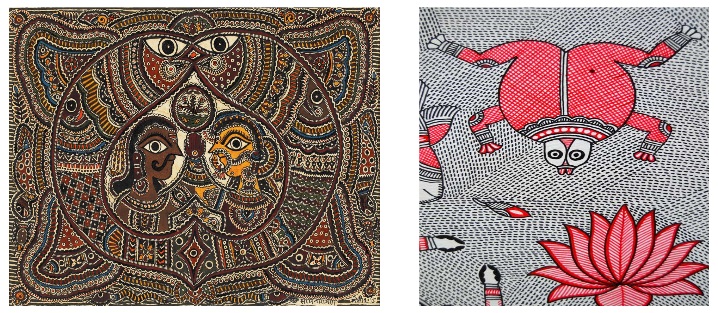
Upper-caste women would paint images of Gods like Radha-Krishna, Rama, Shiva, Ganesha, Laxmi, Saraswati, Tulsi, and Deep weddings and social events. By the fall of the 20th century, Dalit women, primarily from the Dusadh and Chamar communities, started taking up Maithili art in Jitwarpur and Ranti, Bihar villages. These women artists were registered and motivated by a German anthropologist Erika Moses in the 1970s to propagate their style of Madhubani.
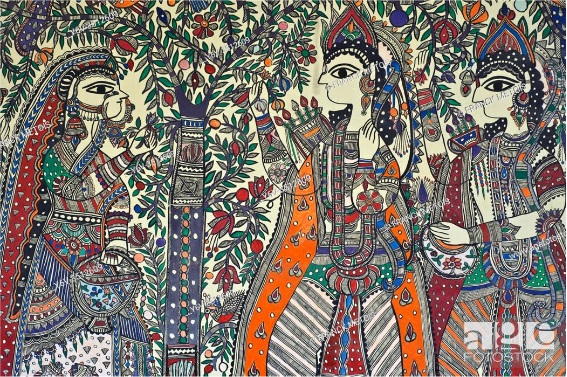
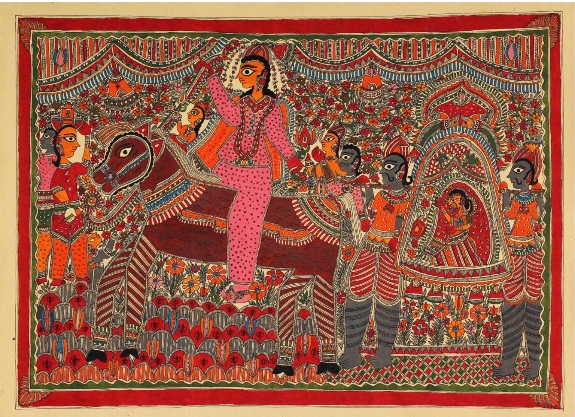
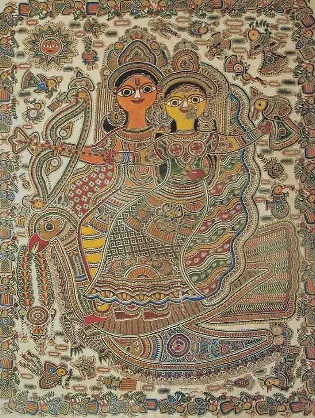
Madhubani paintings by ‘lower-caste’ women, primarily in the Geru (earthy) style or the Godana (tattoo) style, had depth, simplicity, earthy colours and significantly less ornamentation. These paintings also had more elements from nature than Hindu mythology. Lacking knowledge about Hindu gods and rituals, Dalit women artists used different iconologies, visuals and subsequently different Gods: God Surya, Rahu, the tree of Life, and King Salhesh.
According to popular belief, Raja Salhesh had magical powers and ruled the Kingdom of Mahisbathan around fifteen thousand years ago. Some legends suggest he was a King who chose to be born to a lower-caste woman to remove societal differences ultimately. While another legend narrates him as a demigod who served as a watcher at the palace (the primary occupation of the Madhubani painter’s Dalit community of Dusadh) and possessed magical powers. Raja Salhesh symbolises equality and assimilation of Dalits with the rest of the Hindu community with dignity and compassion. Aditi Narayani’s research paper ‘Mithila Paintings: From a Dalit Perspective’ elaborates on the depiction of Raja Salhesh on an elephant is a recurring theme in Madhubani paintings by the Dusadh community.
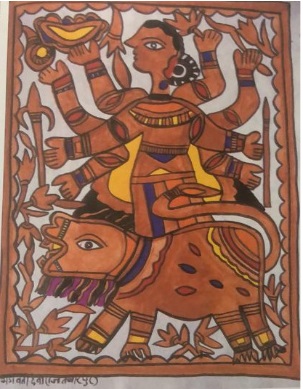
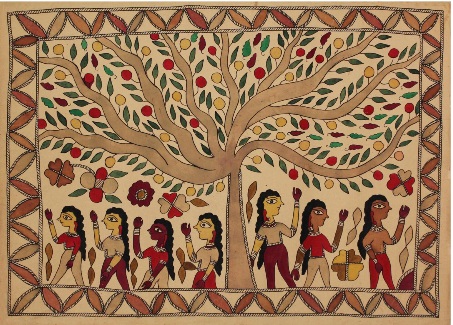
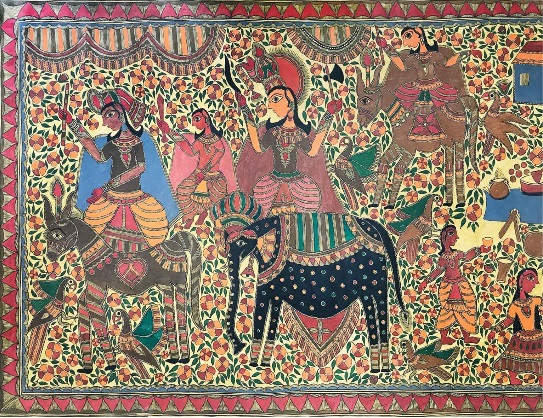
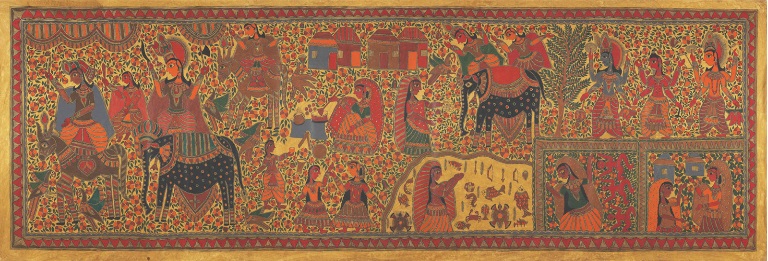
The Godna style (literally meaning ‘to imprint’) of the Madhubani art was traditionally used to mark prisoners. But this style was also used by tribal and Dalit women to decorate the body with rows and concentric circles of dots, flowers, animals, shapes, etc., using a bamboo pen and kajal (lampblack). Chano Devi, the award-winning artist from the Dusadh community, recreated Godna art on paper and later incorporated colours into it. The Godna style also records Raja Salhesh as an essential theme for the paintings.
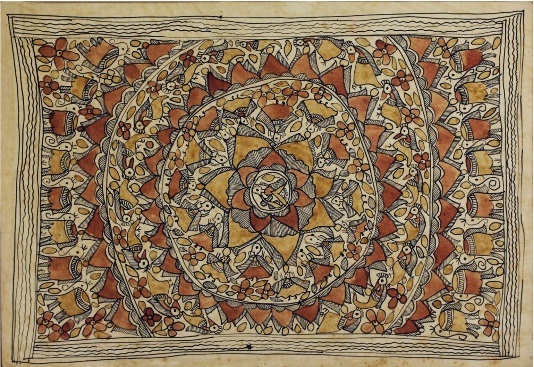
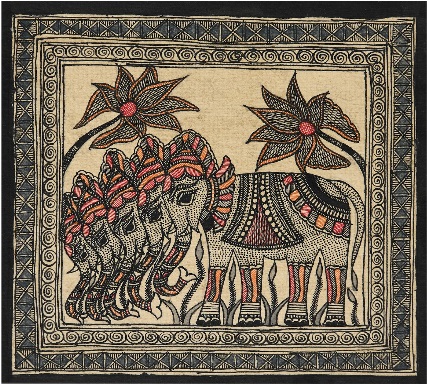
Madhubani: Global Art of ‘all the women’
Before being a means of the depiction of a unique Dalit identity by the use of iconologies of Rahu, Salhesh, Surya, etc., Madhubani is an ‘art’ that is utopianly open to all humans, so ‘is’ made up of ‘all the humans’ of a society.
Jamuna Devi, the first Dalit Maithili painter to win a national award, belongs to the Chamar community of the Mithila region. She invented the style of washing paper with cow dung to give it a solid and earthy texture to draw on. In the Bharni-Katni style (drawing Khobar art and Hindu festival paintings on the walls with bright colours), the upper-caste women borrowed the cow dung wash method to produce their art on paper. In return, Jamuna devi borrowed bright (Holi) colours from the Bharni-Katni style. This amalgamation is more than just a tale of art inspirations but also establishes Madhubani ‘art’ to be bridging the gap between hierarchy segregated castes. The art in the Madhubani is meant to belong to ‘all the women’ who lifted their brushes to decorate their huts and houses.
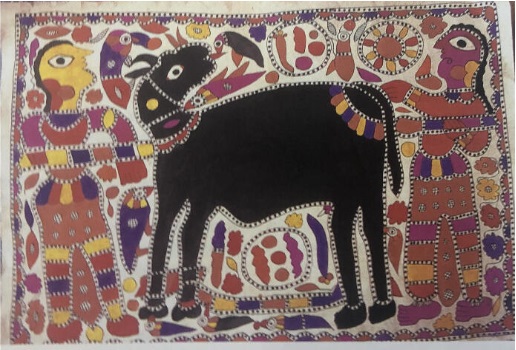
(Courtesy: Samraya)
Madhubani paintings are very natural and momentary, for they were drawn on walls and floors using natural colours by the women of the households. Because of this, the art is historically recorded less. Technically, it recorded even lesser in the case of Dalit women. The rise in the demand for Madhubani in the global market, coupled with the rise in the awareness of the art form, started to give increased respect and worth primarily to Dalit Women. Now, Madhubani has glided from walls and floors to papers, clothes, and digital spaces.
Malvika Raj is a contemporary Dalit artist from Patna whose work, inspired by Khobar Madhubani art, became popular very recently, away from the popular themes of depicting gods and goddesses in Madhubani, her style combined elements of nature with scenes from the lives of Buddha, Ambedkar, Savitribai Phule and other Dalit icons.
“When I started learning the Madhubani technique, the first painting I made was of Krishna. But I felt no connection to it at all; there was nothing for me to relate to. So I started to ask myself what my story was. What is it that would help me connect with my art?”
(excerpt from an interview by FII)
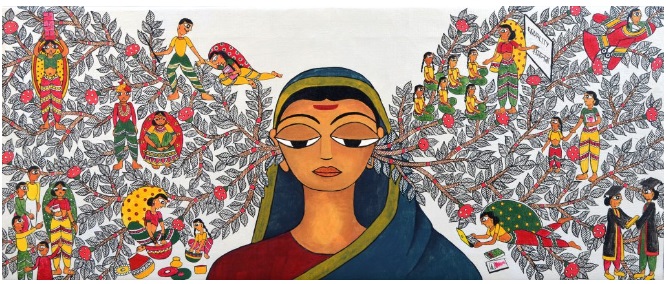
‘Madhubani’: ‘honey forest’
The Madhubani art style is now a much-celebrated art form across the globe. The word ‘Madhubani’, however, translates to ‘honey forest’, belonging to the people of the forests and villages of Mithila. Like other popular art forms of the country, Madhubani became an enterprise of the upper-caste women and laid down rules that segregated the same art based on caste before the 19th century. The history of this art is also punctuated by many European enthusiasts like Moses, who helped bring Madhubani produced by Dalits to light.
But soon, with the start of the 21st century, the Madhubani art of Bihar gave way for Dalit Women to establish their own religious and spiritual ideas using icons of Dalit demigods, political figures, Buddha and nature. Madhubani art, hitting exhibitions in Europe to the lanes of Dilli Haat INA, became an expression of Dalit spirituality and socio-political identity. This a skill that ought to be capitalised on by Dalit women to attain spiritual and financial upliftment.

Contributor


